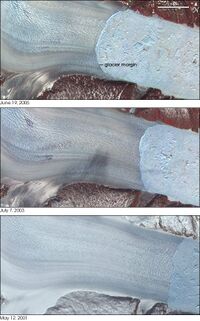Earth:Glacial earthquake
Glacial earthquakes are earthquakes as large as magnitude 5.1 that occur in glaciated areas where the glacier moves faster than one kilometer per year.
The number of glacial earthquakes in Greenland shows a peak every year in July, August, and September, and the number is increasing over time. In a study using data from January 1993 through October 2005, more events were detected every year since 2002, and twice as many events were recorded in 2005 as there were in any other year. This increase in the number of glacial earthquakes in Greenland may be a response to global warming.[1][2]
Seismic waves are also generated by the Whillans Ice Stream, a large, fast-moving river of ice pouring from the West Antarctic Ice Sheet into the Ross Ice Shelf. Two bursts of seismic waves are released every day, each one equivalent to a magnitude 7 earthquake, and are seemingly related to the tidal action of the Ross Sea. During each event, a 96 by 193 kilometers (60 by 120 miles) region of the glacier moves as much as .67 meters (2.2 feet) over about 25 minutes, remains still for 12 hours, then moves another half-meter. The seismic waves are recorded at seismographs around Antarctica, and even as far away as Australia , a distance of more than 6,400 kilometers. Because the movement takes place over such a long period of time—10 to 25 minutes—it cannot be felt by scientists standing on the moving glacier.[3][4] It is not known if these events are related to global warming.[3][5]
See also
References
- ↑ "Archived copy". Archived from the original on 2008-10-07. https://web.archive.org/web/20081007062935/http://people.deas.harvard.edu/~vtsai/files/EkstromNettlesTsai_Science2006.pdf. Retrieved 2009-09-19. Ekström, G., M. Nettles, and V. C. Tsai (2006)"Seasonality and Increasing Frequency of Greenland Glacial Earthquakes", Science, 311, 5768, 1756-1758, doi:10.1126/science.1122112
- ↑ "Archived copy". Archived from the original on 2008-10-07. https://web.archive.org/web/20081007050046/http://people.deas.harvard.edu/~vtsai/files/TsaiEkstrom_JGR2007.pdf. Retrieved 2009-09-19. Tsai, V. C. and G. Ekström (2007). "Analysis of Glacial Earthquakes", J. Geophys. Res., 112, F03S22, doi:10.1029/2006JF000596
- ↑ 3.0 3.1 http://www.scientificamerican.com/article.cfm?id=monitoring-antarctica-ice-movement-is-sticky-business Scientific American "Monitoring Antarctic Ice Movement Is a Sticky Business" June 4, 2008
- ↑ "Antarctic Ice Stream Makes Strange Starts and Stops". LiveScience.com. http://www.ouramazingplanet.com/2194-antarctic-ice-stream-strange-starts-stops.html.
- ↑ "The Antarctic Sun: Earthshaking Discovery". http://antarcticsun.usap.gov/science/contentHandler.cfm?id=1476.
 |


